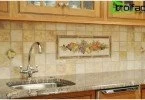What linoleum to choose for the kitchen
For many decades, linoleum has been the most popular and traditional flooring for the kitchen. This unique material is unpretentious in operation, hygienic, has antistatic properties, is easy to fit, and, importantly, relatively inexpensive, depending on the manufacturer and quality. A huge selection of textures and colors that imitate wood, parquet, mosaic tiles, laminate flooring will help create a comfortable atmosphere in the kitchen and organic design of its interior. But do not rush to go shopping, first you need to figure out which linoleum for the kitchen to choose so that it pleases the eye and lasts a long time.
Content
- Natural: durable and chic
- Budget Artificial Linoleum
- Linoleum homogeneous and multi-layer
- Household or semi-commercial?
- Linoleum for the kitchen: properties
- Coating colors and textures
- Tips for buying linoleum
Natural: durable and chic
Many do not suspect that linoleum can be natural. But he was once the first to be made from natural materials such as:
- linseed oil;
- cork and wood flour;
- resin;
- lime powder;
- natural pigments.
Natural fabrics, such as jute fiber or non-woven materials, are used as the basis for this mixture. Ever since the time when natural linoleum was invented, its manufacturing technology has not changed.
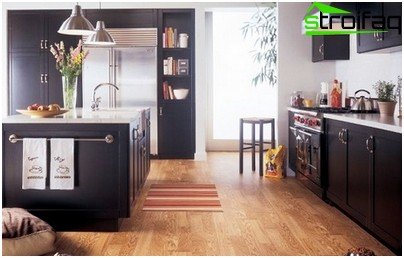
Natural linoleum in the kitchen – a prestigious coating
Natural linoleum is considered the same prestigious flooring as parquet or, say, cork. It has the following positive qualities:
- high strength;
- antistatic;
- resistance to abrasion;
- resistant to fats, aggressive household chemicals, solvents;
- fire resistance;
- excellent heat and sound insulation;
- bactericidal properties.
The most important thing in natural linoleum is its hygiene and environmental friendliness, it retains its unique properties throughout its entire service life (20-40 years!). The only drawback is its rather high cost, when compared with the cost of a synthetic analogue.
Budget Artificial Linoleum
Polyvinyl chloride is the raw material for the production of artificial linoleum, and this fact causes many fears about its environmental safety. Experts assure that high-quality PVC coatings that meet the requirements of GOST and all European standards, have individual advantages of natural linoleum, as well as are completely safe for human health and this gives reason to use them with confidence in the kitchen as a flooring.
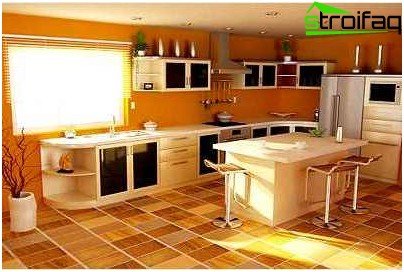
Artificial linoleum for the kitchen is much cheaper than natural
How can one distinguish natural linoleum from its artificial counterpart? First of all, we sniff: artificial coating gives off chemistry, while the natural material exudes a natural oil smell. Secondly, on the inside of the second one can clearly see the jute fiber. Vinyl linoleum is soft and flexible, easily bends. The natural coating is much tougher, it bends like thin plywood when bent. A piece can be broken off from a natural coating if desired, and only cut off from synthetic linoleum.
Both natural and synthetic linoleum are coated with a chemical composition to protect against contamination. Adherents of a healthy lifestyle and environmentally friendly products can choose a coating that was treated not with chemical compounds, but with natural mastics.
Linoleum homogeneous and multi-layer
Artificial coatings are divided into homogeneous (homogeneous) and multilayer (heterogeneous).
Homogeneous they do not have a base, they are uniform throughout the thickness and thin, however, they have elasticity and strength. The pattern penetrates the coating throughout the thickness and this allows you to maintain a satisfactory appearance of the material, even with its uneven wear. Its distinctive feature is a rough surface on which dirt is completely invisible. It is successfully applied in rooms with high traffic. This coating lasts up to 7 years, but this period can be extended if special protective layers are applied..
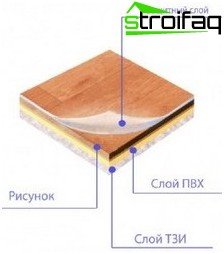
The structure of multilayer linoleum
Heterogeneous coatings have a multilayer structure. It can be presented in the form of a “sandwich” consisting of a base, fiberglass impregnated with PVC paste, a layer of foamed PVC with a pattern applied on it, a protective transparent layer and a chemical or mechanical substrate.
If there is a base on the back of the impregnated fiberglass, then the denser it is, the more heat and sound insulation will be, the linoleum coating will be resistant to deformation. In other words, the higher the density of linoleum, the more it will be resistant to mechanical stress. Choosing linoleum for the kitchen, this parameter can be estimated by comparing the weight of coatings of the same thickness. The heavier the linoleum will be, the greater will be its density, and, accordingly, the service life.
The jute base, similar to burlap, retains excellent heat, however, traces of furniture and heels remain on such linoleum. But the coating with the foamed base is more elastic, soft and durable, such pollution and moisture are not afraid of such linoleum, therefore it is ideal for the kitchen.
Household or semi-commercial?
The top transparent linoleum protective layer (transparency) protects the pattern and determines the abrasion resistance of the material. The thicker this layer, the greater the wear resistance of linoleum and, accordingly, its service life. According to this and other important indicators, heterogeneous linoleums are divided into household, semi-commercial and commercial.
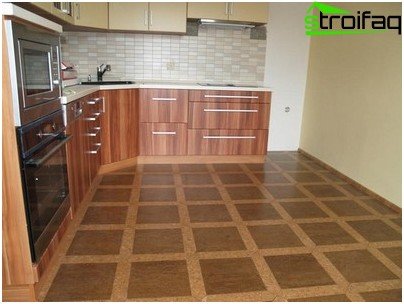
For the kitchen, it is better to choose a wear-resistant semi-commercial linoleum
Although the coating will be intended for use in everyday life, in the kitchen it is advisable to lay not household linoleum, but a semi-commercial one, which is used, as a rule, in rooms with a more intense load and which is characterized by increased wear resistance. It successfully combines the typical for household linoleum ease of use and installation with the “endurance” and unique properties of commercial linoleums.
Linoleum for the kitchen: properties
Kitchen floors must be protected from harmful bacteria and microorganisms, as well as from fungi. In this regard, natural linoleum is the best solution, because it contains linseed oil – a powerful natural antiseptic that will protect not only the floor, but also the indoor air from microbes, and throughout the entire service life.
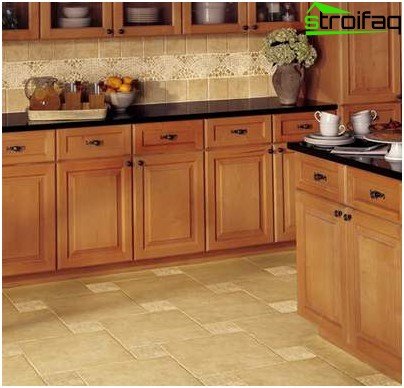
Natural linoleum in the kitchen will retain its protective properties for a long time
Synthetic or artificial linoleum can also have antifungal and antibacterial coatings. This can be, for example, a protective layer with silver microparticles, releasing silver ions into the air, which, as you know, prevent the growth of microbes. Some types of synthetic flooring are also treated with an antifungal compound. However, the protective properties of artificial linoleum, unlike natural, weaken over time.
Coating colors and textures
Currently, the modern types of linoleum on the market are distinguished by a rich selection of colors and textures.
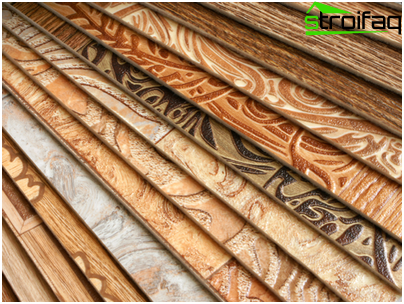
In the assortment there is a cover for the arrangement of any kitchen
Artificial coatings allows you to create cozy kitchen interiors in different styles. The widest decorative possibilities are represented by heterogeneous synthetic linoleum. PVC floor coverings are available in classic yellow-beige-brown tones, but even more pleasing to the eye is a reliable imitation of natural materials – stone, wood, ceramic tiles.
Undoubtedly, the most popular is linoleum, which imitates expensive floor coverings – marble, parquet, mosaic. In the case of parquet imitation, manufacturers of high-quality linoleum achieved not only reproduction of the oak, beech, cherry, as well as exotic species (bamboo, rosewood, zebrano) patterns, but also a natural wood texture.
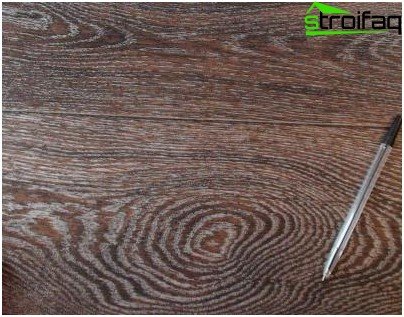
Imitation of natural wood texture on linoleum
At the peak of popularity now – artificial “aging”, when the material looks like shabby wood or stone.
The marquetry technique looks very impressive – a mosaic made of wood veneer. Bold and extraordinary personalities will most likely prefer geometric and abstract drawings with a voluminous design – a great solution for pop art style.
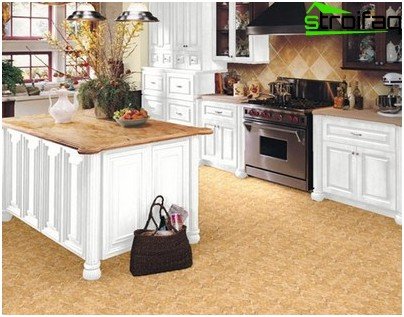
Country linoleum for kitchen
Kitchens in the style of Provence or country are ideally combined with a linoleum coating that imitates an array of solid wood. Plain linoleum with a relief texture will best fit into the interior of a modern or high-tech kitchen.
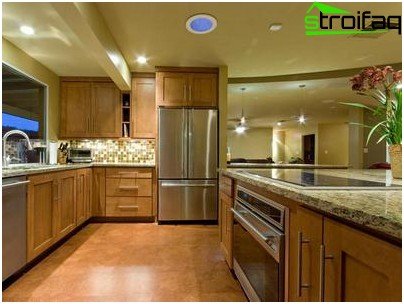
Linoleum with a relief structure fits in the modernist style kitchen
Fans of kitchen classics will definitely choose linoleum for ceramic tiles.
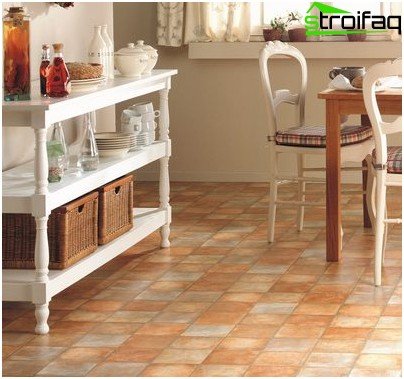
Tile linoleum in the kitchen – for lovers of the kitchen classics
You need to know! A small tile pattern visually enlarges the space of a small kitchen. The same effect can be obtained by placing a “tiled” or “board” pattern diagonally, or by covering the kitchen floor with linoleum of cold light shades.
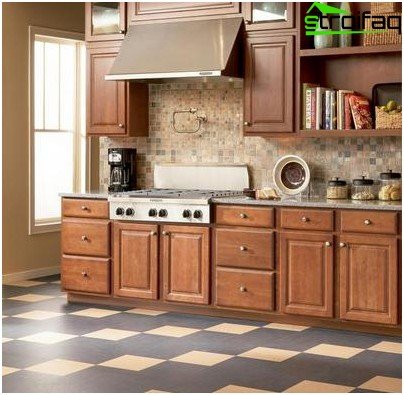
Diagonal tiled pattern enlarges a visually small kitchen.
The warm gamut of colors creates an atmosphere of home comfort, bright and contrasting colors give a boost of vivacity, monotonous drawings soothe. Linoleum, different in color and texture, will help to divide the visually large kitchen into separate functional areas, as well as to separate the kitchen area from the dining room.
Having decided to buy natural linoleum for the kitchen – photos of various design solutions are presented in this article – special attention should be paid to the choice of colors. Why? The thing is that over time, vegetable oils dry out, and the color of the natural coating may temporarily change, although then, under the influence of ultraviolet light, it will again become the same. Beige coatings turn yellow, while gray and blue “turn green”.
Tips for buying linoleum
- Try to choose, based on the size of the room, a wide enough cover to do without unaesthetic joints and seams. Moreover, on the market, the width of the presented linoleum species varies from one and a half meters to four.
- To avoid color and texture discrepancies, pieces of linoleum (if we buy several pieces of coating) should be from the same batch.
- When purchasing linoleum for the kitchen – how to choose it visually, we already know that we must not forget that the heavier the canvas, the greater its density, which means better performance and a longer service life.
- Another important point when choosing linoleum is its anti-slip properties. The embossed embossed surface or special coating with microparticles that enhance friction will minimize the likelihood of injury on a slippery kitchen floor.
- During transportation, linoleum is rolled up, but in no case is it bent, because it can crack when folded.
- Before laying, the roll must be rolled out and let the linoleum rest well..
alternative methods of cleaning linoleum
Now that we have made a short excursion into the rich and diverse world of such an amazing flooring as linoleum, and you are already well versed in which linoleum is better for the kitchen, you can safely go to the store and choose what will be more to your liking and better will fit into the interior of your kitchen.


